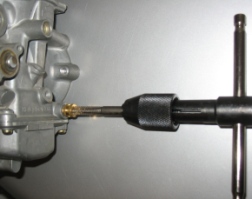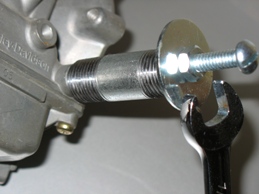|
The stock Harley fuel elbow found on CV carburetors has long been known to be the achilles heel of this carb. The inlet is not only restrictive but made of plastic which breaks easily.
The plastic fuel inlet can crack and leak when removing the original crimp clamp or if over tightened. Also the manner in which the plastic elbow is formed onto a brass insert restricts flow.If you have ever wanted to replace the fuel inlet and increase flow to your CV carburetor read on.In order to remove the original fuel inlet you must first break off the plastic molded elbow. Don’t be shy, get out your favorite hammer or pliers and simply snap the plastic portion off of the carb. It is important to note the angle/position of the original elbow so the fuel line is routed correctly.
Once the plastic is removed only the brass inner portion of the elbow will remain. Some have had luck pulling this piece out with vise grips and brute stength, but more often than not this only results in the brass piece spining endlessly. Below is listed the tools and technique for pulling the fuel elbow insert with ease. |
Tools required:
- Wrench or pliers
- 1/4″-20 thread tap
- 1/4″ x 3″ long machine screw
- 1/4″-20 nut
- 1-1/4″ fender washer (min 1/4″ ID hole)
- 3/8″ x 2″ pipe nipple
|

Fuel elbow removal tools |
| Using a 1/4″-20 tap and T-handle, begin twisting the tap clockwise into the brass stub tapping threads approximately 1/4″ in. Tapping threads all the way through is not necessary as you only need enough for the screw to grab while pulling the old piece out. To prevent excess brass particles from falling back into the carburetor it is advised to hold the carb with the inlet piece facing down so that particles fall away rather than being pushed into the float bowl. |

Tapping the brass stub |
| Assemble the puller. Place the pipe nipple over the brass stub. Thread the nut onto the 3″ screw up to the screw head, then pass the screw through the fender washer. Insert the screw/nut/washer assembly through the pipe nipple and thread a few turns into the tapped brass piece. You only need to thread in enough to grab.With a wrench begin to turn the nut down (clockwise) forcing the screw to lift the brass piece out. It may be easier to hold the screw at the same time with a srewdriver. Once the piece begins to move it will pull out like butter. |

Pull the old fuel inlet stub |
| Remove the pipe nipple, it may be wedged onto the carburetor. Thoroughly clean the fuel insert passage to make sure it is free of any brass filings. Soapy water will wash away any fine particles and not harm the internal parts. Be sure the carburetor is clean and dry.Installing the new fuel elbow will vary depending upon brand or type. Harley dealers sell both an OEM and solid inlet that can be pressed in. Some catalogs carry an OEM replacement inlet but it has the same plastic elbow (not recommended). Harley Performance recommends the CVP Fuel Max Inlet made from a single piece of brass which also improves flow by more than 40%. |
Installing the new inlet elbow
If installing a solid brass or CVP inlet and a press is not available simply tap the inlet into the carburetor with a small mallet. You may also place a piece of wood over the elbow and tap in with a regular hammer. The smooth end presses into the carb and the barbed end is meant to grip the fuel hose.
The brass inlet will self-seal when it is pressed in as long as the carburetor inlet passage is free of debris and not damaged or cracked. A thin layer of blue locktite around the fitting to help seal but care should be taken not to allow any to drip back into the fuel passage as it will damage the rubber tip on the float needle (plunger). |
Note that while working on the carburetor or any fuel system, care should be taken to keep away from any open flame or heat source. NEVER try to loosen carburetor parts using heat.
Replacing the Harley fuel elbow can help guarantee a leak free carburetor, and if installing a hi-flow or CVP Fuel Max Inlet provide increased flow.
Enjoy the Ride!
|
|
